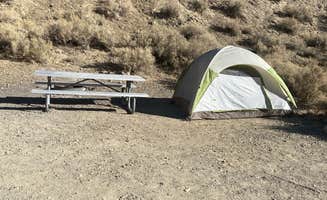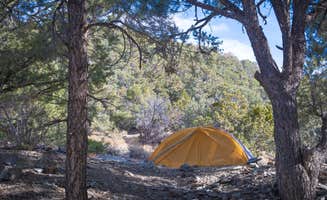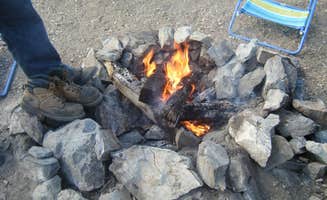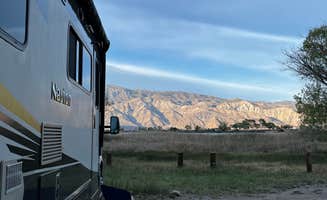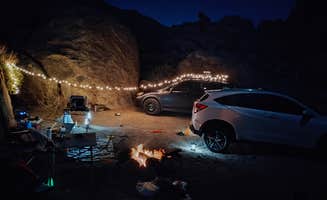Camping opportunities surrounding Darwin, California range across various elevations within the Death Valley region. The area experiences dramatic temperature shifts with winter highs around 70°F in higher elevations and summer temperatures that can exceed 120°F in lower spots. Most dispersed camping requires self-sufficient preparation with all necessary water, as natural sources are extremely limited throughout this arid landscape.
What to do
Hiking near Wildrose: Access the Wildrose Kilns trail 45 minutes from Wildrose Campground for a glimpse of Death Valley's mining history. "It's a long dusty rocky trail but worth it. If you camp here, you might as well go down and check out the giant beehive like kilns," shares Eli W. from Wildrose Campground.
Stargazing at higher elevations: Set up after dark at Alabama Hills for exceptional night sky viewing with minimal light pollution. "The stars and the Milky Way are insane! So many constellations and shooting stars and satellites. Sunset was amazing over Mt. Whitney. The moon rise was quite the experience," notes Rachel W. from Alabama Hills Recreation Area.
Photography at volcanic formations: Visit Fossil Falls for unique geological features formed by ancient lava flows. "Beautiful place to explore during the day and see the lava rocks!" explains Ciara C., adding that it's a "great place to park the car and enjoy the sunset and sunrise."
What campers like
Isolation and silence: Camp at Panamint Valley for true desert solitude. "I loved boondocking here in Panamint Valley. The road is really long, so I'm sure there are a lot of spots. Most of them seem to be spread out 1/4 mile or so. The valley is known for having ZERO background noise," reports Josh P. from Minietta Road.
Higher elevation comfort: Find cooler temperatures at Emigrant Campground during hot months. "Campsite is at 2000 feet so cooler than bottom and way less crowded. Good biking up side roads," explains John H., who appreciates this free tent-only option within the national park.
Desert wildlife sightings: Keep watch for native species around campsites, especially at dawn and dusk. At Panamint Springs, one camper notes: "Sleeping off the ground or in a tent is a must as we catch lots of sidewinders and scorpions every year in the campsite." Brian K. adds that the area provides "a nice view of Panamint valley and mountains to the east."
What you should know
Water availability varies seasonally: Many campgrounds have unreliable water sources. At Emigrant Campground, a camper reports: "Water is not potable year round, will be deemed not potable and/or shut off mid-May per convo with NPS employee. Fill at Stovepipe, Panamint, or elsewhere in summer."
High winds can disrupt camping: Secure equipment thoroughly, especially in open areas. "It was extremely windy with 50+mph gusts which calmed after the sun went down," explains Darla J. at Fossil Falls dry lake bed, while another camper mentions "Make sure your stuff is tied down tight. Upwards for 40mph thought my roof rack was a goner."
Limited cell service: Plan navigation and communication accordingly. "You are literally in the middle of nowhere. No cell phone reception, amenities, nothing, not even shelter, but yet so peaceful and quiet," describes Kristi D. about dispersed camping in the region.
Tips for camping with families
Early arrival essential: Popular sites fill quickly, especially during peak season. "Do not be that guy at 10 PM circling the lot & spotlighting everybody," advises Jason E. at Emigrant. Plan to arrive by early afternoon to secure spots.
Pack for extreme temperature swings: Desert nights can drop 30+ degrees from daytime highs. "It was pretty chilly overnight as this campground is at a higher elevation," notes Julie D. from Tuttle Creek Campground, despite warm days in the area.
Swimming options for hot days: Pay for pool access at established resorts. "For 10$ per person you get a pool and shower pass for all day! The pool is awesome, spring fed warm water. The showers have massive pressure with hot water," reports Deborah C. at Furnace Creek.
Tips from RVers
Level sites at higher elevations: Find better RV parking in established campgrounds like Tuttle Creek. "Most sites are very close to level. Packed dirt roads around campsites in good condition," notes Leonard H. about this BLM option near Alabama Hills.
Limited hookups outside resorts: Most dispersed camping lacks facilities. "We stopped here on a whim and stayed for about 5 days. It was surprisingly rocky upon entering the park and made pulling our camper through there a bit more of a mission," shares Philip D. at Fossil Falls Campground, adding that "No dump sites nearby though."
Prepare for road conditions: Many access roads require careful driving. "The road is maintained but a smidge bumpy and uneven but should be easy for most cars," reports a camper at Fossil Falls, while others warn about high-clearance requirements for more remote locations.



